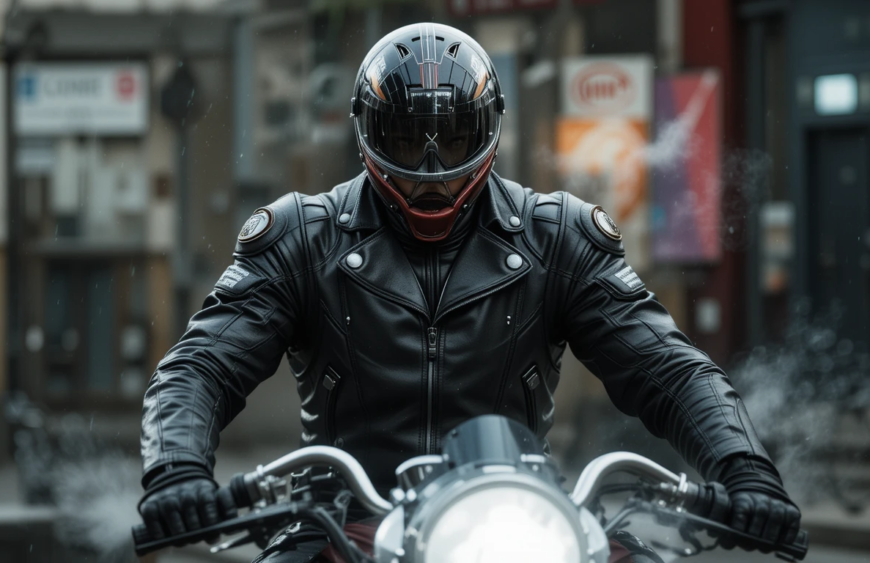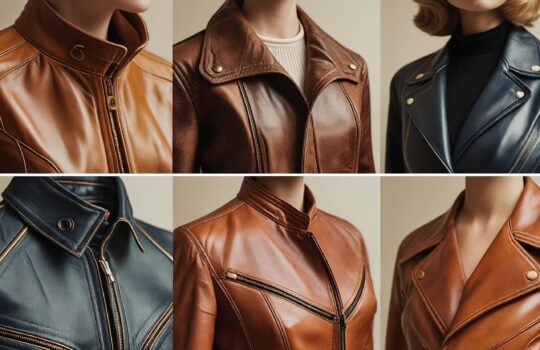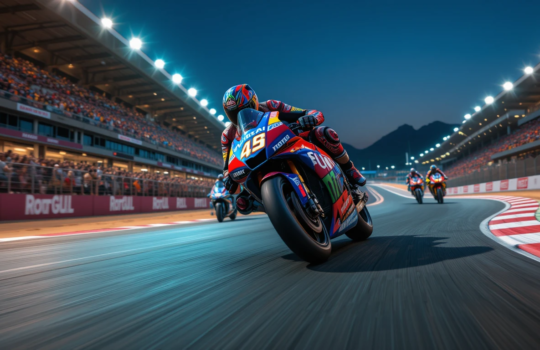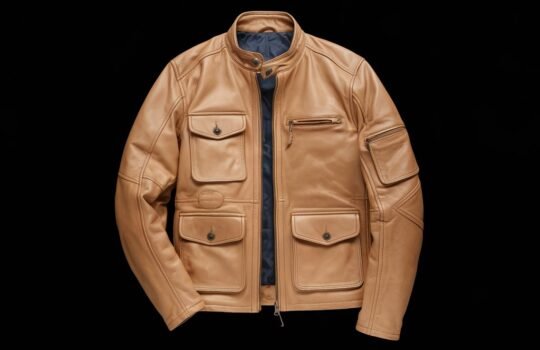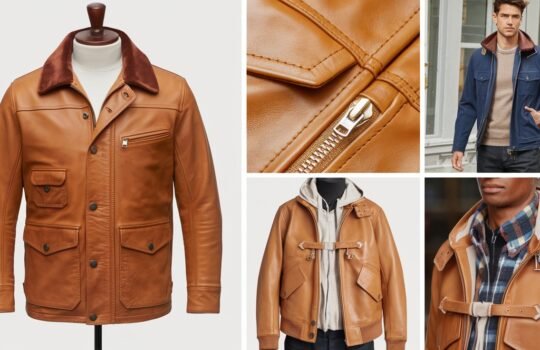Best Motorcycle Leather Suit: The Ultimate Buying Guide for Riders
Introduction to Motorcycle Leather Suits
A motorcycle leather suit is one of the most essential pieces of riding gear for motorcyclists, especially for those who prioritize safety, durability, and performance. Whether you’re a racer, tourer, or a city commuter, a high-quality leather suit offers impact protection, abrasion resistance, and comfort. Unlike textile riding gear, leather suits provide superior protection in case of crashes or slides, reducing injuries significantly.
The demand for customized leather motorcycle suits has grown, allowing riders to have tailored fits and unique designs while maintaining CE-certified safety standards. But how do you choose the best one? This guide covers everything—from leather types, safety features, fitting guides, and maintenance tips to help you make an informed decision.
Why Leather is the Best Choice for Motorcycle Gear
When it comes to motorcycle protective gear, leather is widely regarded as the best material for suits, jackets, and gloves. Here’s why:
1. Unmatched Abrasion Resistance
Leather, particularly full-grain cowhide or kangaroo leather, offers high abrasion resistance, protecting riders in case of a slide. Unlike textile suits, leather holds up well against road friction, minimizing skin injuries.
2. Superior Impact Protection
Most CE-certified motorcycle leather suits are equipped with armor inserts at critical points like shoulders, elbows, knees, and back, providing excellent shock absorption in case of accidents.
3. Better Fit and Comfort
Leather suits contour to the rider’s body over time, offering a snug and ergonomic fit. Many suits come with adjustable panels to allow freedom of movement while maintaining protection.
4. Weather Resistance & Longevity
High-quality leather is naturally water-resistant and, with proper maintenance, can withstand various weather conditions. Leather suit durability for motorcycle riding is superior to textile gear, lasting years if maintained correctly.
5. Stylish & Timeless Look
Unlike synthetic materials, leather suits age gracefully, developing a unique patina over time. They are also available in various colors and designs, making them a preferred choice among style-conscious riders.

Types of Leather Used in Motorcycle Suits
The type of leather used in a motorcycle leather suit significantly affects durability, protection, and comfort. There are several types available:
1. Cowhide Leather Motorcycle Gear
Cowhide is the most common leather used in motorcycle suits due to its high abrasion resistance and durability. It is thick and offers excellent impact protection.
2. Buffalo Leather Motorcycle Suits
Buffalo leather is slightly tougher and has a more pronounced texture compared to cowhide. It is highly durable and water-resistant, making it a great choice for all-weather riders.
3. Benefits of Kangaroo Leather for Riders
Kangaroo leather is lighter and more flexible than cowhide while offering comparable strength. This makes it a preferred choice for racing suits where agility and comfort are essential.
4. Synthetic Leather Motorcycle Suits
Some riders opt for synthetic leather suits, which are made from engineered materials. While they are affordable and lightweight, they lack the abrasion resistance and durability of genuine leather.
Each type of leather has its pros and cons, and choosing the right one depends on your riding style, budget, and personal preferences.
Full-Grain vs. Top-Grain vs. Split Leather: What’s Best?
Leather processing affects the quality and protective capabilities of a motorcycle suit. Understanding the difference between full-grain, top-grain, and split leather helps in choosing the right gear.
1. Full-Grain Leather Motorcycle Suits
- Highest quality and most durable
- Retains the natural grain, making it tougher and more resistant
- Develops a beautiful patina over time
- Used in high-end, premium motorcycle suits
2. Top-Grain Leather vs. Split Leather
- Top-grain leather is sanded and treated for a smoother appearance, making it more flexible and comfortable than full-grain.
- Split leather (or corrected leather) is made from the lower layers of the hide and is less durable than top-grain or full-grain leather.
For motorcycle suits, full-grain and top-grain leather are the preferred choices due to their balance of durability, flexibility, and protection.
Comparing Cowhide, Buffalo, and Kangaroo Leather Suits
| Feature | Cowhide Leather | Buffalo Leather | Kangaroo Leather |
|---|---|---|---|
| Durability | High | Very High | Moderate |
| Flexibility | Moderate | Stiff initially | High |
| Weight | Heavy | Heavy | Lightweight |
| Abrasion Resistance | High | Very High | High |
| Comfort | Breaks in over time | Becomes softer with use | Naturally flexible |
Each type of leather has unique advantages, and riders should choose based on their comfort preferences, protection needs, and riding environment.

Synthetic Leather Motorcycle Suits: Are They Worth It?
While genuine leather is known for its durability and abrasion resistance, some riders prefer synthetic leather motorcycle suits for affordability and ethical reasons.
Pros of Synthetic Leather Suits
✅ Lightweight & flexible – More comfortable for casual riders.
✅ Affordable – Costs significantly less than genuine leather.
✅ Vegan & eco-friendly – No animal materials used.

Cons of Synthetic Leather Suits
❌ Less durable – Wears out faster than genuine leather.
❌ Weaker abrasion resistance – Less protection in crashes.
❌ Poor breathability – Can be hot and uncomfortable in summer.
For serious riders and racers, genuine leather suits remain the best choice due to their superior safety and durability.
Motorcycle Leather Suit vs. Textile Riding Gear
1. Protection & Safety
Leather offers better abrasion resistance than textile gear, making it the top choice for high-speed riding and racing.
2. Comfort & Fit
- Leather suits mold to the rider’s body over time, offering a snug, ergonomic fit.
- Textile suits provide more flexibility but may not offer the same level of impact protection.
3. Weather Resistance
- Textile gear is generally more versatile for rain and extreme cold, while leather requires waterproof treatments to handle wet conditions.
For serious riders, leather remains the best option, but for touring riders or those needing all-weather protection, textile gear can be a viable alternative.
Leather Suit Durability for Motorcycle Riding
When investing in a motorcycle leather suit, durability is one of the most critical factors to consider. A well-crafted leather suit not only provides long-term protection and comfort but also withstands the rigors of riding, weather exposure, and potential crashes. Understanding what affects leather suit durability ensures that you select a suit that lasts for years while maintaining optimal performance.

1. Factors That Affect Leather Suit Durability
Several elements determine how long a motorcycle leather suit will last:
a) Quality of Leather
The type of leather used in a suit directly impacts its lifespan. Full-grain cowhide and kangaroo leather are among the most durable options, as they retain the natural grain structure, making them resistant to wear and tear.
- Full-grain leather: Most durable, retains natural strength, highly abrasion-resistant.
- Top-grain leather: Moderately durable, sanded for smoothness but slightly weaker.
- Split leather: Least durable, made from the lower layers of the hide.
b) Stitching and Construction
A high-quality leather suit is defined by its stitching and construction. Double or triple-stitched seams with Kevlar reinforcement significantly increase longevity and tear resistance. Look for:
- Double or triple-stitched seams for added durability.
- Reinforced panels at impact zones like shoulders, knees, and elbows.
- Stretch panels to prevent excessive stress on stitching.
c) Protective Coatings and Treatments
Premium leather suits are treated with protective coatings to enhance water resistance, UV protection, and flexibility. These treatments help prevent premature cracking or fading. Some suits come with:
- Water-resistant coatings to prevent moisture damage.
- UV-resistant finishes to maintain color and prevent sun damage.
- Special oils and waxes to improve flexibility and longevity.
d) Frequency of Use and Maintenance
A leather suit that is worn frequently without proper maintenance will degrade faster. Regular conditioning, cleaning, and storage significantly impact how long a suit lasts.
2. How to Prolong the Lifespan of a Leather Suit
Maintaining a motorcycle leather suit properly ensures that it remains durable and protective for years. Here’s how to maximize its lifespan:
a) Clean the Suit Regularly
- Use a damp microfiber cloth to remove dirt and bugs after every ride.
- For deep cleaning, apply a leather cleaner and gently wipe the surface.
- Avoid using harsh detergents or excessive water, as these can weaken the leather.
b) Condition the Leather
- Apply a high-quality leather conditioner every few months to keep the material flexible and prevent cracks.
- Choose non-greasy, breathable conditioners designed specifically for motorcycle gear.
c) Store the Suit Properly
- Keep the suit in a cool, dry place away from direct sunlight.
- Use a breathable garment bag to protect against dust and moisture.
- Avoid folding the suit; instead, hang it on a padded hanger to maintain its shape.
d) Waterproofing Solutions
- Apply a leather waterproofing spray to protect against rain and moisture.
- If the suit gets wet, let it air dry naturally at room temperature—never use direct heat like hairdryers or radiators.
By following these steps, a high-quality leather suit can last 5 to 10 years or more, providing reliable protection and comfort throughout its lifespan.
Breathable Leather Motorcycle Gear for Comfort
One of the major concerns among riders is whether a motorcycle leather suit offers breathability. Traditional leather is not naturally breathable, but modern advancements in ventilation design, perforation techniques, and inner linings have significantly improved airflow.

1. Importance of Breathability in Motorcycle Leather Suits
A breathable leather suit is essential for temperature regulation, especially in hot weather conditions. Lack of proper airflow can cause:
- Excessive sweating, leading to discomfort and distraction while riding.
- Heat buildup, making long rides unbearable.
- Increased fatigue, reducing focus and reaction time on the road.
2. Features That Improve Breathability in Leather Suits
a) Perforated Leather Panels
Many modern motorcycle leather suits incorporate perforated panels in strategic areas like:
- Chest and shoulders to enhance airflow.
- Inner thighs to prevent heat buildup.
- Back area to allow moisture escape.
Perforated leather helps maintain cooler temperatures inside the suit without compromising protection.
b) Ventilation Zippers and Mesh Panels
Some leather suits come with zippered ventilation panels, allowing riders to adjust airflow as needed. These are especially useful for:
- Summer riding when maximum ventilation is needed.
- Layering in winter, where zippers can be closed for insulation.
c) Moisture-Wicking Inner Linings
High-end leather suits feature moisture-wicking fabric linings that absorb sweat and keep the rider cool and dry. These linings also:
- Prevent skin irritation from prolonged contact with leather.
- Help regulate body temperature in varying climates.
- Offer easy removal for washing and maintenance.
d) Stretch Panels for Air Circulation
Many leather suits include stretch fabric inserts in areas like the underarms, groin, and knees. These panels not only enhance mobility but also allow air to circulate more effectively.
3. Best Leather Motorcycle Suits for Summer Riding
Riders who frequently ride in hot climates should consider suits designed specifically for summer use. Features to look for include:
✅ Perforated full-grain leather for optimal airflow.
✅ Removable moisture-wicking inner linings.
✅ Ventilation zippers on the chest and back.
✅ Stretch panels for enhanced breathability.
Some manufacturers even offer two-piece leather suits with detachable sections, allowing more flexibility for warmer temperatures.

4. How to Stay Cool While Wearing a Leather Suit
Even with a breathable suit, here are some additional ways to stay cool while riding in leather:
- Wear a moisture-wicking base layer under the suit to absorb sweat.
- Take breaks in the shade during long rides to avoid overheating.
- Stay hydrated to regulate body temperature.
- Use cooling vests or damp bandanas inside the suit for extra cooling.
By selecting the right breathable leather motorcycle gear, riders can experience comfort, protection, and ventilation even in extreme heat conditions.
Water-Resistant Leather Motorcycle Suits
Riding a motorcycle in unpredictable weather conditions means that riders must be prepared for rain and moisture. Since traditional leather is not naturally waterproof, investing in a water-resistant leather motorcycle suit ensures protection, durability, and comfort in wet conditions.
1. Importance of Water Resistance in Motorcycle Leather Suits
A water-resistant leather suit offers multiple benefits:
- Prevents water absorption: Leather absorbs moisture, leading to stiffness and damage.
- Maintains comfort: Wet leather becomes heavy and uncomfortable to wear.
- Enhances durability: Proper waterproofing protects against cracking and deterioration.
Without proper waterproofing, a motorcycle leather suit can become damaged, brittle, and lose its protective qualities over time.
2. Features of Water-Resistant Leather Suits
a) Water-Resistant Leather Treatments
High-end motorcycle suits undergo specialized treatments to make them resistant to moisture and rain. These include:
- Silicone-based coatings that repel water.
- Wax-based leather treatments that add an extra layer of protection.
- Hydrophobic leather finishes that prevent water from soaking in.
b) Sealed or Waterproof Stitching
Standard stitching can allow water to seep through the seams. Premium motorcycle leather suits use:
- Sealed seams to prevent moisture penetration.
- Waterproof stitching materials, such as nylon or Kevlar-coated thread, to enhance durability.
c) Waterproof Inner Linings
A high-quality waterproof suit features inner membranes like:
- Gore-Tex® linings that allow breathability while repelling water.
- Moisture-wicking layers that keep riders dry inside the suit.
These linings prevent dampness from seeping in, ensuring a comfortable ride in wet conditions.
3. How to Waterproof a Leather Motorcycle Suit
If your leather suit isn’t naturally waterproof, there are DIY methods to enhance its water resistance:
a) Apply Leather Waterproofing Sprays
- Use a high-quality waterproofing spray designed for motorcycle gear.
- Apply evenly over the entire suit, focusing on seams and high-exposure areas.
- Reapply every few months or after heavy rain exposure.
b) Use Leather Conditioners with Water Repellents
- Conditioners with beeswax or silicone help create a moisture barrier.
- Apply after cleaning the suit to maintain flexibility and protection.
c) Store the Suit Properly After Riding in Rain
- Never dry a wet suit near direct heat (like heaters or dryers).
- Let it air dry naturally at room temperature.
- Apply conditioner afterward to prevent cracking.
4. Best Water-Resistant Leather Suits for Riders
Riders looking for the best water-resistant leather motorcycle suits should choose suits with:
✅ Full-grain or top-grain treated leather for superior water resistance.
✅ Sealed stitching and waterproof liners.
✅ Removable waterproof layers for multi-season use.
✅ Breathable yet waterproof materials to balance comfort and protection.
By investing in a water-resistant motorcycle leather suit, riders can stay dry, comfortable, and protected, even in unpredictable weather conditions.
Leather Suit Fit and Sizing Guide
A well-fitted motorcycle leather suit is essential for comfort, safety, and performance. A suit that is too tight can be restrictive, while a suit that is too loose can fail to provide adequate protection. Understanding leather suit fit and sizing ensures you get the perfect balance of comfort and safety.
1. Importance of a Proper Fit in Motorcycle Leather Suits
An ill-fitting leather suit affects both performance and safety:
- Tight suits restrict movement, making riding uncomfortable.
- Loose suits can cause armor to shift, reducing impact protection.
- Incorrect sizing can lead to fatigue and poor posture during long rides.
2. How to Measure for a Leather Suit
To get the right leather motorcycle suit size, take accurate body measurements using a flexible measuring tape. The key areas to measure include:
| Measurement Area | How to Measure |
|---|---|
| Chest | Measure around the widest part of your chest, just under your armpits. |
| Waist | Measure around your natural waistline, typically above the belly button. |
| Hips | Measure around the widest part of your hips. |
| Inseam | Measure from the crotch to the bottom of your ankle. |
| Arm Length | Measure from your shoulder to your wrist with your arms relaxed. |
3. Leather Suit Sizing Chart
Each manufacturer has different size guidelines, so always check the leather suit sizing chart provided by the brand. Below is a general size chart for motorcycle leather suits:
| Size | Chest (inches) | Waist (inches) | Inseam (inches) |
|---|---|---|---|
| Small (S) | 36-38 | 28-30 | 30-32 |
| Medium (M) | 38-40 | 30-32 | 31-33 |
| Large (L) | 40-42 | 32-34 | 32-34 |
| X-Large (XL) | 42-44 | 34-36 | 33-35 |
Pro Tip: Always try the suit in a riding position to ensure proper fit and flexibility.
4. Adjusting Leather Suits for Better Comfort
a) Breaking in a New Leather Suit
- Wear the suit around the house for short periods.
- Go for short rides before using it on long trips.
- Use leather stretch sprays to loosen tight areas.
b) Stretching Leather Suits for a Better Fit
If the suit feels too tight, consider:
- Wearing it with thermal layers to allow gradual stretching.
- Using a professional leather stretching service.
- Applying leather softening oils to increase flexibility.
c) Common Issues with Ill-Fitting Leather Suits
- Too Tight: Causes discomfort, restricts movement, and limits airflow.
- Too Loose: Armor shifts out of place, reducing safety and impact protection.
- Wrong Proportions: Arm or leg length doesn’t match body measurements, causing ride discomfort.
5. Custom Leather Suits vs. Off-the-Rack Options
For riders with unique body proportions, a customized leather motorcycle suit is often the best solution. Custom suits offer:
✅ Tailored fit for maximum comfort.
✅ Customization options for colors and features.
✅ Proper armor placement for enhanced safety.
However, off-the-rack suits are more affordable and suitable for riders with standard body shapes.
Armor Compatibility with Leather Suits
1. Importance of Armor in Motorcycle Leather Suits
A motorcycle leather suit offers excellent abrasion resistance, but armor plays a crucial role in impact protection. Without proper armor, a rider is vulnerable to severe injuries in case of a crash. High-quality armor compatibility with leather suits enhances safety, providing extra protection in key impact zones.
Key benefits of armor in motorcycle gear:
- Impact Absorption: Reduces the force transferred to the body during a crash.
- Injury Prevention: Protects against fractures, bruises, and joint injuries.
- Enhanced Safety Ratings: Meets safety standards required for motorcycle protective gear.
2. Types of Armor Used in Leather Motorcycle Suits
Modern leather suits are designed to accommodate different types of protective armor. The most common types include:
a) CE-Certified Armor
CE-certified armor is tested under EN safety standards to ensure optimum impact protection.
- CE Level 1 Armor: Offers basic protection with lighter weight and flexibility.
- CE Level 2 Armor: Provides higher impact absorption, best for track racing and high-speed riding.
b) Hard-Shell vs. Soft-Shell Armor
- Hard-Shell Armor: Made of polycarbonate or Kevlar, best for high-speed crashes.
- Soft-Shell Armor: Constructed from memory foam or viscoelastic materials, ensuring comfort and impact dispersion.
c) Hybrid Armor
A combination of hard-shell and soft-shell materials, providing a balance between flexibility and protection.
3. Key Areas for Armor Placement in Leather Suits
A well-designed leather motorcycle suit incorporates armor in high-impact zones:
| Armor Placement | Purpose |
|---|---|
| Shoulder Armor | Protects the collarbone and upper arms from impact. |
| Elbow Armor | Shields the forearm and elbows from fractures. |
| Back Protector | Reduces spinal injuries in rear impacts. |
| Knee Armor | Essential for leg protection in slides or falls. |
| Hip Armor | Absorbs side impacts, protecting the pelvis area. |
Pro Tip: Always check armor compatibility when buying a motorcycle leather suit, ensuring it has removable or upgradeable armor pockets.
4. Upgrading and Adjusting Armor for Better Fit
Not all leather motorcycle suits come with high-quality armor. Riders often upgrade their armor for better protection:
- Replace factory armor with CE Level 2 alternatives.
- Adjust the positioning of armor to ensure a snug, secure fit.
- Use aftermarket armor inserts that fit inside pre-existing armor pockets.
5. Best Motorcycle Leather Suits with High-Quality Armor
For maximum safety, choose motorcycle leather suits that offer:
✅ Full-body CE-certified armor.
✅ Adjustable armor pockets for customization.
✅ Hybrid armor designs for flexibility and impact absorption.
By ensuring proper armor compatibility, riders can significantly reduce injury risks, making their leather motorcycle suit a complete protective gear.

Temperature Regulation in Leather Motorcycle Suits
1. The Challenge of Temperature Control in Leather Suits
Leather is known for its durability and protection, but it can also be hot in summer and cold in winter. Proper temperature regulation in leather motorcycle suits ensures comfort in different weather conditions.
Challenges of poor temperature regulation:
- Overheating in hot weather, causing sweat buildup and discomfort.
- Cold penetration in winter, making riding uncomfortable.
- Reduced performance, as extreme temperatures affect focus and endurance.
2. Ventilation Features in Leather Motorcycle Suits
High-end leather suits are designed with ventilation systems that enhance airflow and temperature control.
a) Perforated Leather Panels
- Tiny holes allow airflow, reducing heat buildup.
- Used in chest, arms, and leg areas for better cooling.
b) Mesh and Air Intakes
- Strategically placed air vents let air circulate through the suit.
- Helps in evaporating sweat, keeping riders cool and dry.
c) Moisture-Wicking Liners
- Absorb sweat and prevent odor buildup.
- Quick-drying materials enhance riding comfort.
3. Insulation and Thermal Layers for Cold Weather
For winter riding, leather suits incorporate thermal linings:
- Removable thermal layers trap body heat.
- Fleece and insulated inserts enhance warmth.
- Windproof outer shells protect against cold air penetration.
4. Choosing the Best Leather Suit for Seasonal Riding
Riders who ride in varying weather conditions should consider:
✅ Multi-season leather suits with removable layers.
✅ Breathable leather panels for airflow in hot weather.
✅ Thermal lining options for cold-weather riding.
By selecting a leather suit with proper temperature control, riders can ensure comfort, breathability, and enhanced endurance.
Summary
A motorcycle leather suit is one of the most important investments for riders, offering protection, durability, and style. By choosing the right type of leather, ensuring proper armor placement, and maintaining a good fit, riders can enhance their safety and riding experience.
Key takeaways:
- Choose high-quality leather (full-grain, top-grain, or buffalo leather) for durability.
- Ensure proper armor compatibility to enhance impact protection.
- Pay attention to sizing and adjustability for a comfortable fit.
- Select water-resistant and temperature-regulated suits for year-round riding.
- Maintain your leather suit with regular conditioning and cleaning.
A well-maintained, properly fitted leather motorcycle suit enhances both safety and riding performance, ensuring years of reliable protection on the road.
FAQs
1. What is the best leather for motorcycle suits?
Full-grain leather is the best option for motorcycle suits, offering superior durability, abrasion resistance, and longevity. Kangaroo leather is another premium choice due to its lightweight yet high-strength properties.
2. How do I choose the right size for a leather motorcycle suit?
Measure your chest, waist, hips, and inseam to compare against a leather suit sizing chart. Ensure the suit fits snugly but allows flexibility, especially in a riding position.
3. Can I wear a leather motorcycle suit in hot weather?
Yes, but choose a suit with perforated leather panels and ventilation features. Moisture-wicking liners and breathable designs help keep riders cool in hot weather.
4. How often should I condition my leather motorcycle suit?
Condition your leather suit every 3-6 months to prevent cracking and maintain flexibility. Use high-quality leather conditioners and store it in a cool, dry place.
5. What are the key safety certifications for motorcycle leather suits?
Look for CE-certified armor (Level 1 or Level 2), EN-certified materials, and reinforced stitching. These features ensure the suit meets safety standards for impact protection.
4 Pocket Black Leather Jacket
46 MOTORCYCLE LEATHER RACING JACKET
A2 USAF Pilot Leather Flight Jacket with Faux Fur Collar
Adrenaline Rush Moto America 2025 Motorcycle Leather Racing Jacket
Adrenaline Rush MotoGP 2025 Motorcycle Leather Racing Jacket
AdventureMaster Dakar Rally 2025 Motorcycle Leather Jacket
Read More: How to Choose the Right Motorcycle Suit for TT
